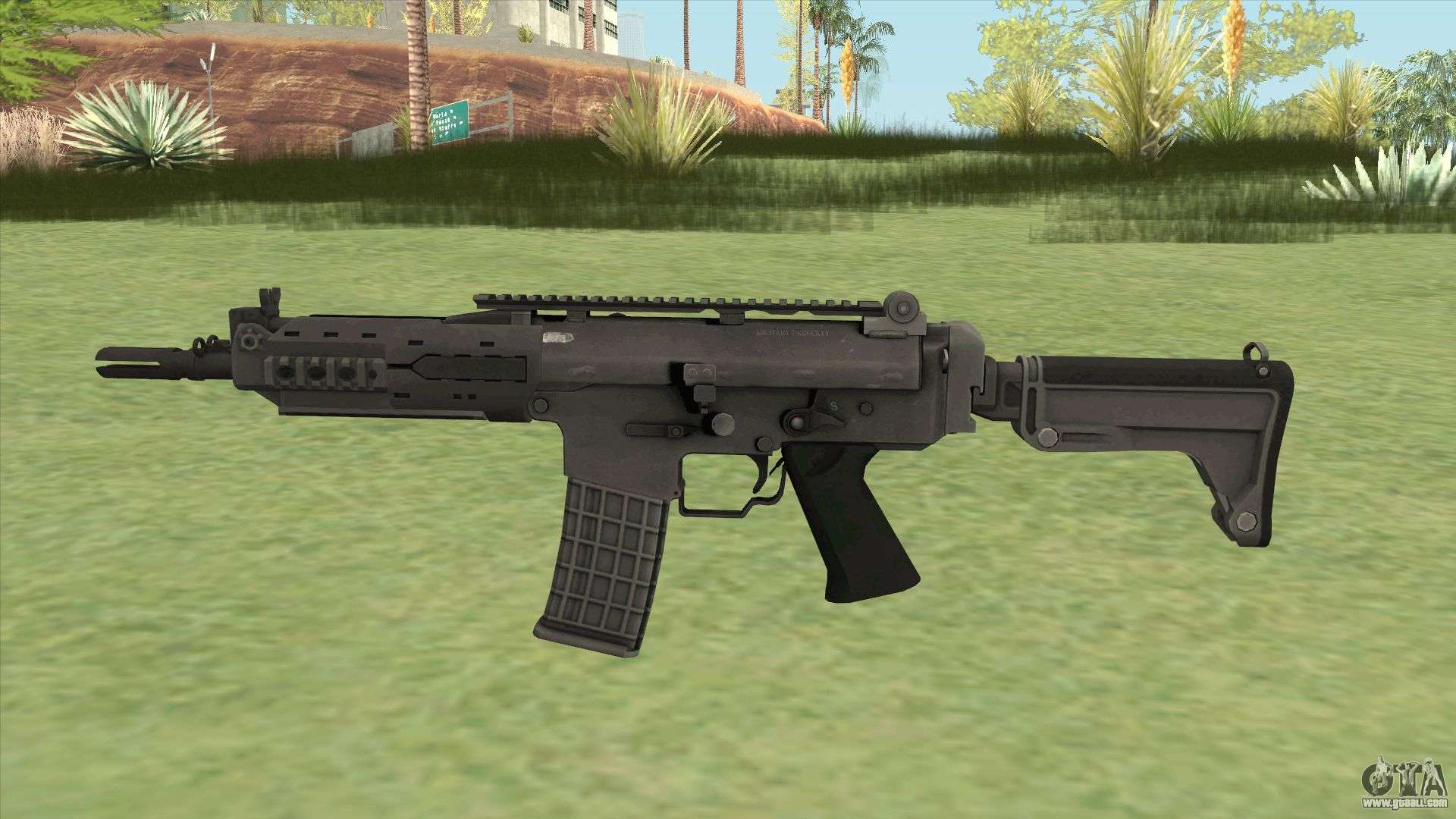Assault Carbine - An Airman with the Ohio Air Force Security Forces fires an M4 carbine (a shorter, lighter variant of the M16A2 weapon) during a 2017 target practice.
Most modern carbines are rifles that are compact versions of a longer rifle or rifles chambered for less powerful cartridges.
Assault Carbine

The smaller size and light weight of carabiners make them easier to handle. They are typically issued to highly mobile forces such as special operations soldiers and paratroopers, as well as cavalry, artillery, logistics or other non-infantry personnel whose duties do not require a full-size rifle, although the tdcy of carbines is increasing. distributed to front-line soldiers to offset the increasing weight of other issued equipment. An example of this is the US Army's M4 carbine, which is standard equipment.
M4a1 Ris Assault Carbine With Blank Dog Tags On Camouflage Uniform Stock Image
From Old Frch carbine (a soldier armed with a musket), the origin of which is unclear. One theory links it to an "ancient engine of war" called a kalabe;
In 1432, during the reign of Sejong the Great, the Joseon Dynasty introduced the world's first pistol called the Se-chongtong [ko] (세총통). Se-chongtong has a total length of 13.8 cm, an inner diameter of 0.9 cm and an outer diameter of 1.4 cm. He is held by his cheolheumja (철테자, iron grip), which allows him to quickly change the muzzle for the next shot, and fires a chase-jeon (차세전, modern patterned arrow) with a maximum lethal range of 200 paces (≈250 meters). Initially Joseon considered the weapon a failure due to its short effective range, but the se-chongtong was quickly adopted after reaching the border provinces from June 1437. The se-chongtong was used by soldiers and civilians of various units, including women and children. , as a personal defense weapon. The weapon was primarily used by chetamja (체타자, special intelligence), whose task was to penetrate enemy territory, and carbines carrying various weapons that corresponded to its compact size.
The carbine was originally developed for cavalry. In early modern warfare around the 16th century, infantry were armed with firearms, so cavalry did the same, although loading barrel-loaded firearms while on horseback was highly impractical.
Some cavalry, such as the German Reiter, added one or more pistols, while other cavalry, such as the arquebusiers, experimented with various shorter and lighter versions of the infantry's arcabuz weapons—the first carbines. However, these weapons were still difficult to reload during mounting, and the sword often remained the main weapon of this cavalry. Dragoons and other cavalry dismounted for battle generally adopted standard infantry firearms, although some versions preferred them to be less cumbersome when mounted, something that could be arranged to keep the rider off the elbows and the horse's legs.
Ics Airsoft M4a1 Aeg Assault Carbine Rifle W/ Le Stock
Although more portable, carbines had the general disadvantages of less accuracy and power than longer infantry weapons. During the Napoleonic Wars, cavalry armed with pistols and carbines often transitioned to traditional melee cavalry, or dragoons. Carbines are more widely used outside regular cavalry and infantry, such as support troops and artillery, who may need to defend themselves from attack, but carrying full-sized weapons at all times would hinder their performance; In the late 19th century, the common name for many short rifles was the artillery carbine.
As the rifle musket replaced the infantry's smoothbore firearms in the mid-19th century, carbine versions were also developed; it was often developed separately from the infantry rifles, and in many cases did not even use the same ammunition, making supply difficult.
A notable weapon developed by the Union at the end of the American Civil War was the Spencer carbine, one of the first repeating weapons.

It had a spring-loaded detachable tube magazine that held seven rounds and could be reloaded by inserting spare tubes. It was intended to give the cavalry a replacement weapon that could be fired from horseback without the need to clumsily reload after each shot—although it served primarily as a cavalry weapon, as was typical during the war.
Fallout Nv Assault Carbine By Spartan22294 On Deviantart
By the end of the 19th century, the production of both full-length and carbine rifles had become common in many countries. One of the most popular and recognizable carbines was the lever-action Winchester carbine, with several versions available as revolver cartridges. This made it an ideal choice for cowboys and explorers, as well as other residents of the American West, who could carry both a revolver and a carbine using the same ammunition.
The Lee field Cavalry Carbine, a shortened version of the British Army's standard infantry rifle, was introduced in 1896, although it did not become the standard weapon of the British cavalry until 1903.
In the decades following World War I, the standard battle rifle used by armies around the world became shorter, either due to redesign or the general creation of carbine conversions in place of full-size rifles. This movement was started by the US Model 1903 Springfield, originally produced in 1907 with a 24-inch (610 mm) short barrel, which produced a short rifle that was longer than a carbine but shorter than a standard rifle, so that it could be issued to all troops. without the need for separate versions.
Other countries followed suit after World War I when they learned that their traditional long-barreled rifles were of little use in the trenches and proved to be nothing more than a hindrance to soldiers. Examples include the Russian Model 1891 rifle, originally with an 800 mm (31 in) barrel, later shortened to 730 mm (29 in) in 1930 and 510 mm (20 in) in 1938, German Mauser Gewehr 98 rifles weighing from . 740 mm (29 in) in 1898 to 600 mm (24 in) in 1935 as the Karabiner 98k (K98k or Kar98k) or "short carbine".
Hk 416 Assault Carbine For Gta San Andreas
The barrel length of rifles used in the United States did not change between the World War I M1903 rifle and the World War II M1 Garand rifle, as the M1903 still had a shorter 610 mm (24 in) barrel. Model 1891 and Gewehr 98. The US M1 carbine was more of a traditional carbine as it was significantly shorter and lighter with a 457.2 mm (18.00 in) barrel than the M1 Garand rifle and was intended for rearguards who could not stop a full size rifle but something more powerful and accurate than the Model 1911 pistol was needed (although this did not stop soldiers from using them on the front lines). Contrary to popular belief and what some books claim, the M1 Carbine was not a shorter version of the .30-06 M1 Garand, as is typical of most rifles and carbines. , but it had a completely different design, firing a smaller, less powerful cartridge. The "M1" marks both as the first models in the new US designation system, which no longer uses the year of introduction, but a consecutive series of numbers beginning with "1": M1 carbine and M1 rifle.
The UK developed a "Jungle Carbine" version of its Lee Field Service Rifle with a shorter barrel, flash suppressor and manufacturing changes designed to reduce the weight of the rifle.
Officially titled Rifle, no. The 5 Mk I entered service in the closing months of World War II, but did not see widespread service until the Korean War, the Mau Mau Uprising and the Malayan Emergency, and the Vietnam War.

The shorter weapon was more convenient when attached to a truck, armored car, helicopter or plane, and also when used in close combat. Based on the combat experience of the Second World War, the criteria for the selection of infantry weapons began to change. Unlike earlier wars, which were often fought primarily through fixed lines and trenches, World War II was a highly mobile war, often fought in cities, forests, or other areas where mobility and visibility were limited. In addition, improvements in artillery made moving infantry into operational areas even less practical than before.
Assault Carbine Hi Res Stock Photography And Images
Most of the enemy contact was less than 300 meters (330 yd) away, and the enemy came into contact with fire only briefly as they moved from cover to cover. Most of the shots fired were not aimed at the enemy fighter, but rather towards the enemy to prevent them from moving and firing back. These situations did not require a heavy rifle, firing full-powered rifle bullets with long-range accuracy. An even less powerful weapon would result in casualties at the shortest range if counterattacked in real combat, and the reduced recoil would allow more shots to be fired in the short time the enemy was visible. Lower-capacity ammunition would also weigh less, allowing the soldier to carry more ammunition. A shorter barrel can be used without requiring a long barrel to fire full power ammunition. A shorter barrel made the gun weigh less, was easier to handle in tight spaces, and easier to load quickly to fire at an unexpected target. Fully automatic fire was also considered a desirable feature, allowing the soldier to fire short bursts of three to five rounds, increasing the probability of hitting the target.
Assault, jbl carbine, assault carbine gra, carbine, halo assault carbine, assault carbine fallout new vegas, 9mm carbine, assault carbine new vegas, carbine parts, carbine kit, carbine case, carbine buttstock
0 Comments